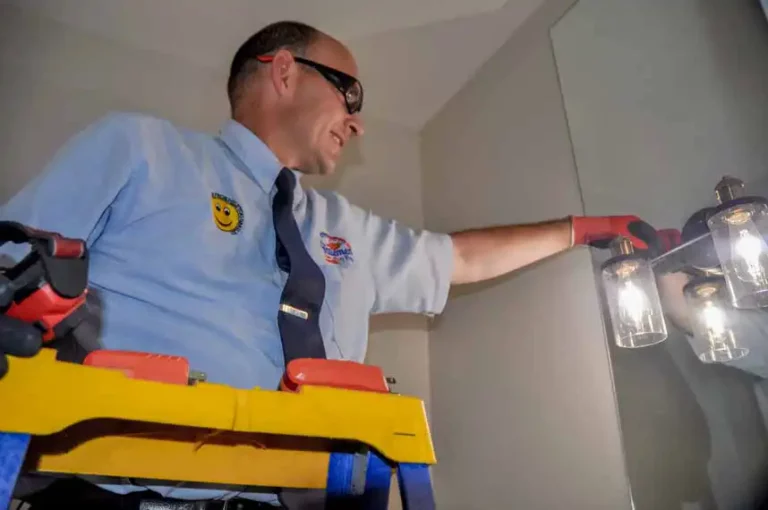
Same Day Service
Since 2001
Call The Gentleman Pros Now!
(403) 879-1759

Your ceiling fan might just be one of the most underrated pieces of equipment in your home.
“Julian was professional and thorough with the assessment required to understand the ongoing dripping sound we have noticing from the exhaust fan in the master bedroom washroom! Julian provided a lot of helpful information to help me as a home owner with the electrical panel and other components in the mechanical room! A very knowledgeable, friendly and helpful experience!”
Arjun Katik

They can make a big difference in regulating a room’s temperature. Room all stuffy and the air is stagnant? Turn on your ceiling fan. Room too hot? Turn on your ceiling fan. Room too cold? Turn on your ceiling fan.
We’ve all entered a stale room and we can agree, it isn’t very pleasant. A ceiling fan moves a room’s air around leading to increased air circulation, a cooler room in the summer, a warmer room in the winter, and fresher rooms year round.
When the blades move in the counterclockwise direction, they can make the room feel cooler. Ceiling blades don’t lower the actual temperature. But the room does feel cooler because of the “wind chill effect”. The ceiling fan moves the air across your skin making you feel cooler.
Ceiling fans also help your air conditioner by increasing a room’s air circulation. Cool air tends to hang out in the lower areas of the room, you know — the floor. So even though your air conditioner is working well, the air just hangs out near the floor cooling your ankles. When operating in a counterclockwise direction, the ceiling fan blades pull the cool air up so it circulates through a larger area of the room.
Most people know a ceiling fan helps cool a room but did you know it can help heat a room too? A ceiling fan helps distribute the heat your furnace pumps out. Because hot air rises, a lot of the heat produced by your furnace ends up close to the ceiling. Your ceiling fan can push that heat down into the room.
Did you know ceiling fans can rotate in both a clockwise and counterclockwise direction? To redistribute heat, the ceiling fan blades need to be moving in a clockwise direction.
By effectively using your ceiling fan to increase air circulation and help cool or heat a room, you can increase your energy savings. Because you are getting more out of your cooled or heated air, you reduce the amount you use your air conditioner or furnace.
You can turn the temperature up on your air conditioner and down on your furnace which means you are using less energy to operate them. Some say you can save up to 15 percent on your heating bills if you use a ceiling fan.
Then give Calgary Gentlemen Pros a call. We’ve been in business for over 20 years and if you are replacing an old ceiling fan or putting one where there isn’t a fan, we can help.
Our professional electricians will determine what needs to be done, explain the scope of work to you, complete the job, and clean up after themselves. And we will provide a transparent quote before any work is started.
Our helpful customer service representatives are standing by 24/7 to answer your call. So give us a ring at (403) 879-1759 and they’ll book our next available electrician to give you a visit.
You can also talk to us online using the Chat With Us button at the bottom right of this page or you can fill out our online contact form.
Let us make you smile by professionally installing your ceiling fan for you.
If you’d like to learn how to choose a ceiling fan, check out our tips here.
This is the second post in our Electrical Glossary series to help you understand what your tradesperson is talking about. Click here for Part 1.
This installment deals with the different types of circuits.
Soon you’ll be conversing with your tradesperson like an expert.
There are two types of electricity: current and static. The electricity in our houses is current electricity and needs a circuit to travel on. Simply, a circuit is a circular pathway made of conductive materials that starts at the electricity’s source and ends at the source.
A series circuit is a circuit where all the components (items that draw power, i.e. outlets, light fixtures) are connected one after the other on one single path for electrical current flow.
If the electricity fails at any point on the circuit, it impacts all the items on the circuit.
Series circuits are not used in homes because they are an unreliable method of wiring and failure impacts every single device on the circuit.
The electrical circuits in our houses are more complex than one simple loop. Our electricity runs on a parallel circuit.
A parallel circuit still starts and ends at the source. But instead of one direct circular path to and from the source, a parallel circuit’s path divides into several individual branch circuits that all meet back up with the main circuit.
In our homes, electricity enters our homes from the grid on two thick black wires. These two wires attach to the two hot bus bars in the electrical panel. The incoming electricity is divided amongst the various branch circuits through the circuit breakers attached to the bus bars.
The electricity on each branch circuit runs back to the main panel on the white neutral wire which attaches to the neutral bus bar. From here the electricity is returned to the grid (the source) on one neutral wire.
The voltage remains the same on each of the branch circuits, 120 V on a standard household branch circuit. What is divided is the current which is measured in amps. Typically a branch circuit will deliver 15 to 20 amps, though some will deliver a higher amperage depending on the branch circuit’s need.
The total amps delivered by all the branch circuits cannot exceed the total amperage your house has. Homes built today often have a 200-amp service but homes built earlier often have a smaller amperage service.
Parallel circuits are used in houses because it is a much more reliable way to deliver electricity than series circuits. If one of the branch circuits fails, it doesn’t impact the remaining branch circuits.
A parallel circuit is made up of individual “sub” circuits that divide off the main circuit and then join back up with the main circuit before the circuit returns to the source. These individual “sub” circuits are called branch circuits.
In our homes, a branch circuit breaks off the main circuit at the electrical panel to feed electricity to a specific area. It rejoins the main circuit before it returns to the electrical panel.
For a more in-depth discussion on series and parallel circuits, check out this site.



